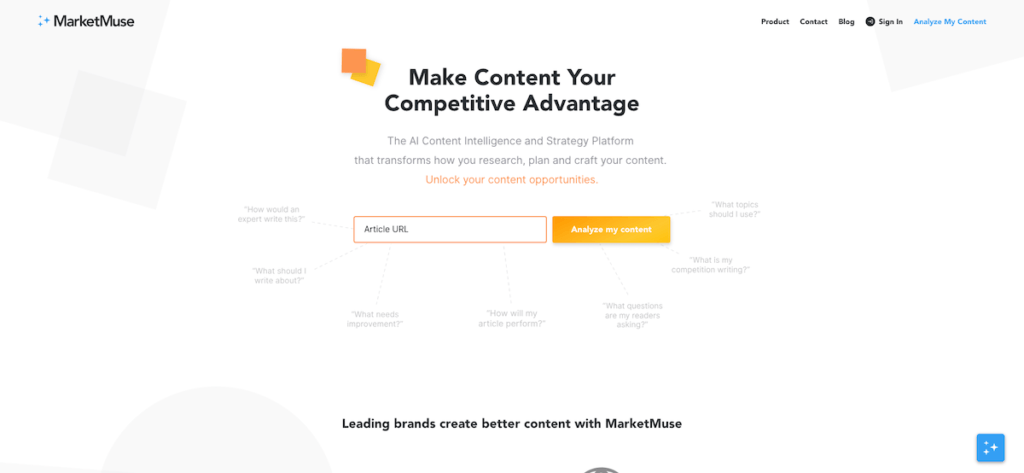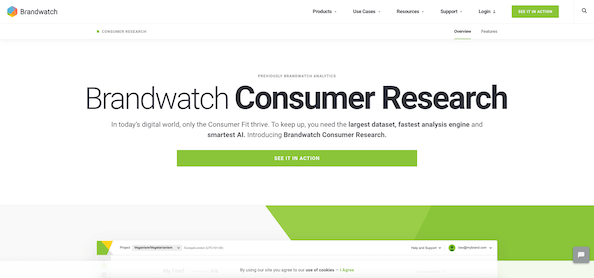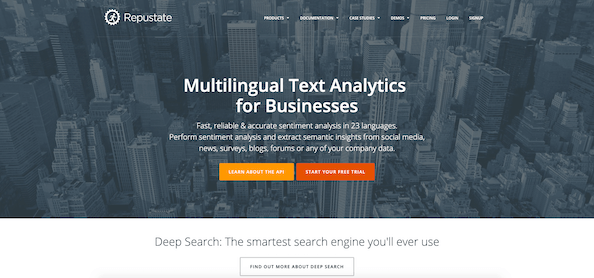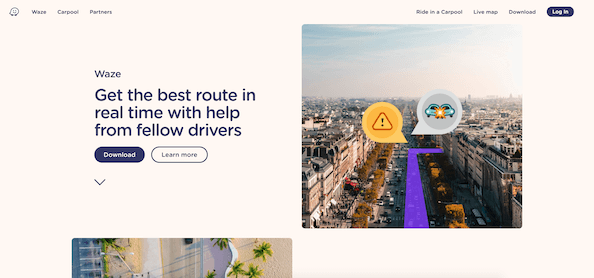4 Natural Language Processing Applications and Examples for Content Marketers
In previous posts, I’ve talked about what natural language processing is and how it can help you streamline and scale content creation.
But it’s hard to really visualize how it works without examples. In this post, I’ll go over four functions of artificial intelligence (AI) and natural language processing and give examples of tools and services that use them.
By understanding how content marketing services apply NLP and AI, you should get a pretty good picture of how you can use this still-developing tech for your brand.
1. Analyzing Content
There are all kinds of reasons to analyze content. You can analyze your existing content for content gaps or missed topic opportunities (or you can do the same to your competitors’ content).
It can analyze your social content for you to understand how people feel about your brand. You can use a content analyzer to create a chatbot or to determine trending topics that are worth writing about.
Finally, content analysis is the first step in translation from one language to another.
Let’s break out some of the functionality of content analysis and look at tools that apply them.
Content Analysis
Natural language processing uses both syntax and semantics to understand the meaning behind content.
Smart devices like Google Home and Alexa uses natural language processing to understand search queries and commands. Gmail uses NLP to anticipate what you’ll write in an email and then make suggestions to autofill.

Then, there’s language analysis for content marketing. MarketMuse, for example, uses natural language processing to analyze your existing content, as well as that of your competitors. You can also use it to make decisions on the kinds of new content you should be creating.
Of course, you can use it to check for content gaps or opportunities to expand single pieces of content into clusters. But it also does something really extraordinary.
It crawls individual pieces of content using NLP to flag thin content and suggests opportunities to deepen your topic coverage. It will even suggest subtopics to cover, as well as questions to answer and primary and secondary keywords to include.
Sentiment Analysis
Content marketers use sentiment analysis in three ways. First, there’s social listening. Marketing teams use sentiment analysis tools to essentially listen in on what people are talking about online and how they’re talking about it.
If a controversial topic is trending on Facebook, Instagram, or other social media platforms, sentiment analysis will pick up on people’s reactions. Are people reacting positively or negatively? Are they part of your target audience? How (if at all) should your brand weigh in on the topic?
Content marketers also use sentiment analysis to track reactions to their own content on social media. Sentiment analysis tools look for trigger words like wonderful or terrible. They also try to analyze the semantic meaning behind posts by putting them into context.
Finally, sentiment analysis can be used for A/B testing. Content marketers can use a tool to scan their own content before it’s published, whether that be a social post or landing page text. The tool uses learned online behaviors to determine whether or not your content will be received well before it’s even published.
Here are some examples of tools that can perform sentiment analysis.
Brandwatch

Through their Consumer Research product, Brandwatch allows brands to track, save, and analyze online conversations about them and their content. Audience research includes topic sentiment, as well.
Repustate

Repustate is made specifically for sentiment analysis. It can analyze content in 23 languages across social media, news, blogs, and other online channels to help brands track reactions to their content and specific topics.
HootSuite Insights

HootSuite is a social media management platform that includes sentiment analysis as part of its tracking functionality. Once you’ve posted content, Hootsuite will track it for the usual analytics as well as positive or negative reactions to your content.
Understanding Content
A part of analyzing content using NLP is understanding it in context.
Elements of human speech such as slang, sarcasm, and idioms make it difficult to truly understand the meaning behind text without context. But some programs use AI to learn collective results as well as previous encounters with human speech to improve their ability to understand language.
Understanding content is also a big part of answering and analyzing questions. Search engines, for example, are getting much better at understanding human queries and giving back an answer that satisfies user intent.
If you ask Alexa, “What’s the hottest coat this season?”, you probably want to know the hottest coat trend and not which coat is the warmest. Alexa needs to understand that distinction to give you the answer that best matches your query.
Amazon Comprehend and IBM Watson Discovery

Amazon Comprehend and IBM Watson Discovery can accomplish all of the tasks I’ve already mentioned by understanding patterns in human language. It can pull in large amounts of unstructured text such as customer service tickets, social media posts, and product reviews, to find commonalities in the language and deliver insights to stakeholders.
Word Sense Disambiguation
Word sense disambiguation is part of understanding natural language. This type of NLP is used mainly for translation. It’s the process of taking words and phrases that could have multiple meanings and narrowing it down to just one. Once that’s done, a translation tool can generate a more accurate result in another language.
BabelScape Comprehendo

This tool allows the translation of both standard text and text snippets (tags, search queries, etc.). It can aggregate text through semantic analysis.
NLTK
The Natural Language Toolkit (NLTK) is an open-source natural language processing tool made for Python. It can be customized to suit the needs of its user, whether it be a linguist or a content marketing team looking to include content analysis in their plan.
Generating Content
Every time your smartphone talks to you or your Gmail auto-finishes a sentence, you’re using natural language generation (NLG). Through this process, an app or program takes raw data and turns it into a coherent response that sounds natural to the human ear.
NLG is especially important in creating chatbots to answer customer questions. But it’s also used in translation tools, search functionality, and in GPS apps.
Waze

Crowdsourcing GPS app Waze is an excellent example of NLG. Like all GPS apps, it comes with a standard female voice that guides you as you drive. But you can also download voice packs of famous people like Arnold Schwarzenegger and Mr. T to make your drive just a bit more entertaining.
To do that, the app has to be taught to understand the accent and language patterns of a given celebrity to generate believable language.
Text Summarization
Text summarizers are very helpful to content marketing teams for several reasons. Text summarizations can be used to generate social media posts for blogs as well as text for newsletters. Marketers can also use it to tag content with important keywords and fill in other metadata that make content more visible to search engines.
In academic circles, text summarization is used to create content abstracts.
To summarize a text, an NLP tool pulls the main ideas and keywords from a text and generates a summary using NLG. The challenge for AI and machine learning has always been figuring out just what those main ideas and keywords are.
But the technology is getting better and better, and there are a variety of tools to help you accomplish exactly the kind of summarization you need. There are even chrome extensions that can help you out, though it might be hard to scale content summaries that way.
Auto Summarizer
Auto Summarizer is a free, web-based tool. You simply copy and paste your text into the WYSIWYG, and the tool generates a summary.
If you publish just a few pieces a month and need a quick summary, this might be a useful tool. But this isn’t the text analytics tool for scaling your content or summarizing a lot at once.
Summary
Natural language processing may have started as a purely academic tool, but real-world applications in content marketing continue to grow. NLP, AI, and machine learning allow brands to pinpoint the exact audience for their product or service and target them with the right content. It makes research, planning, creating, tracking, and scaling content an achievable goal instead of a marketing pipe dream.
Now, if AI could just write our blog posts, that would be something!
What you should do now
When you’re ready… here are 3 ways we can help you publish better content, faster:
- Book time with MarketMuse Schedule a live demo with one of our strategists to see how MarketMuse can help your team reach their content goals.
- If you’d like to learn how to create better content faster, visit our blog. It’s full of resources to help scale content.
- If you know another marketer who’d enjoy reading this page, share it with them via email, LinkedIn, Twitter, or Facebook.
Laurie is a freelance writer, editor, and content consultant and adjunct professor at Fisher College. Her work includes the development and execution of content strategies for B2B and B2C companies, including marketing and audience research, content calendar creation, hiring and managing writers and editors, and SEO optimization. You can connect with her on Twitter or LinkedIn.